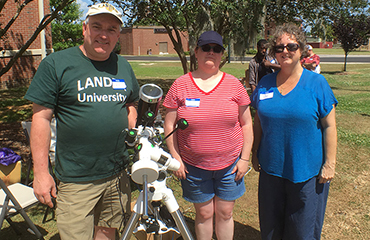
Greenwood is one of many U.S. cities in the path of a rare coast-to-coast solar eclipse coming on August 21 - and Lander University will be a prime place to witness it.
Whether it's using a sunspotter, making a pinhole projector, or viewing the entire 2.5 minutes of totality from the university's front lawn, students, faculty and staff will find plenty of activities to keep their interest.
"Plans to celebrate the total solar eclipse are well under way," said Kelly Hughes, chair of the solar eclipse planning committee and technical services manager with Lander's Information Technology Services. "Everything is starting to come together."
To date, plans for eclipse day include:
"I'm really excited that I'm going to be here when the eclipse happens," said Lander freshman Drew Robertson, a physical education major. "It should be an experience I'll never forget."
Leading up to the eclipse will be training and preparation for a team of Lander participants in using a solar telescope and a CCD camera - a charge-coupled device, first invented in 1969, which can convert light into electrons and deliver high-quality image data.
Initial training in using this equipment was held May 19-20 at S.C. State University under the direction of Dr. Donald Walter, state coordinator for the Citizen CATE experiment.
Hughes, and professors Dave Slimmer and Michelle Deady, comprised the Lander CATE team.
"The training was intense with a lot of steps involving data collection, but it went really well," Hughes said. "Everybody's excited about this."
In June and July, the Lander CATE team will conduct several equipment practice sessions by observing the moon and sun.
"Each observing session requires 75 steps and takes two hours to complete," Dr. Walter said. "On the day of the eclipse, every CATE team will record nearly 800 images for future analysis."
Counting Lander, more than 60 observation sites in the U.S. were selected across the path of the eclipse where totality will take place.
The American Astronomical Society in Washington, D.C., estimates that more than 10 million people are in the 65-mile-wide path of the total eclipse - the first one to cross the U.S. coast-to-coast since June 1918 - and both Walter and Hughes said the experience will be a "once-in-a-lifetime opportunity."
"I'm just hoping that when the day of the eclipse comes, the weather will cooperate," Hughes said. "I've never experienced a total solar eclipse before, and I'm looking forward to the experience."